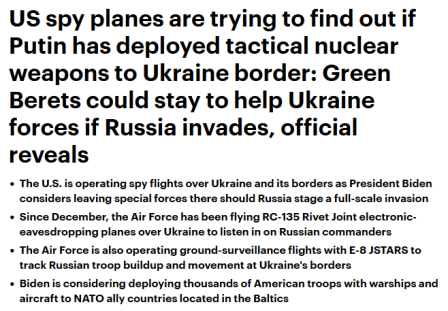File:Tactical nukes question - as of January 28 2022.png
Tactical_nukes_question_-_as_of_January_28_2022.png (448 × 311 pixels, file size: 115 KB, MIME type: image/png)
Wire Services / https://www.dailymail.co.uk/
January 28, 2022
Nuclear Weapons in Europe ... Tactical/Strategic Background
- Security Perspectives, Security Demands: Russia, Ukraine, NATO, US, European nations
If one steps back and takes a broader look at the causes of potential war over the issue of Ukraine, the issue takes on a larger security perspective, i.e., nuclear weapons "modernization" and next generation "smart", "dial-up" tactical nuclear weapons imminently being deployed in Europe and other theaters.
The modernization of nuclear weapons post Cold War nuclear triad strategies, and the Mutually Assured Destruction (MAD) era of massive nuclear retaliation with 'launch on warning' command and control to assure land-based missile capabilities to respond to perceived preemptive attack has led to a new era, one of so-called small nukes.
They are not small, they are profoundly dangerous to real security and the current European, East-West standoff over Ukraine, demonstrates how these next generation nuclear weapons are bringing on new iterations of nuclear danger.
Quick Scan, Nuclear Weapons - Data
January 2021
The Bulletin of the Atomic Scientists on the current status of the US nuclear arsenal appears to confirm that about 100 B61s are now stationed at US bases across five European countries, down from previously reported estimates of 150.
The nukes are said to be stationed in Italy (at the Aviano and Ghedi bases), Germany (Buchel Air Base), Belgium (Kleine Brogel base), the Netherlands (Volkel base), and in Turkey (Incirlik). Researchers attributed the drop in deployed nukes to a "reduction of operational storage capacity at Aviano and Incirlik," with about 130 B61s now said to be stored at bases in the US and kept ready for operations in Asia or other locations outside Europe.
March 2021
Moscow has spent years calling on Washington and its allies to remove all US nuclear weapons from Europe, with both Russian and European officials describing them a “relic of the Cold War.” Russia has also criticised the NATO concept of “nuclear sharing,” which allows non-nuclear power allies to take part in the planning of operations using nukes. Russia argues that in addition to arousing tensions and suspicions in Russia-NATO relations, NATO “nuclear sharing” is a violation of the Treaty on the Non-Proliferation of Nuclear Weapons.
F-35s and Tactical Nuclear Weapons Deployment
The US military committed to upgrading its arsenal of B61 bombs in the mid-2010s, opting for the creation of a smaller variant known as the B61-12, the testing of which was recently shown at the Tonopah Test Range in Nevada. The weapon is touted for its ability to be carried inside an F-35’s internal weapons bay. The bomb has four yield options: 0.3 kilotons, 1.5 kilotons, 10 kilotons, and 50 kilotons. For comparison, the nuclear bombs which the US dropped on Hiroshima and Nagasaki in August 1945 were equivalent to about 15 and 18 kilotons, respectively.
June 2021
WASHINGTON ― NATO allies are poised to formally oppose the alliance deploying ground-based nuclear missiles in Europe, following U.S. President Joe Biden’s meeting with fellow heads of state set for June 14 in Brussels, Defense News has learned.
The position, which echoes past remarks from Secretary General Jens Stoltenberg, is set out in a draft communiqué for release after the NATO summit, according to one U.S. Senate aide and one European official, who spoke on condition of anonymity in order to discuss the closely held document.
A NATO spokesperson on Sunday declined to comment on the communiqué's contents, saying the discussions were ongoing.
The potential move is seen as possible way to ease tensions with Moscow and to tee up an arms control dialogue ahead of the U.S.-Russia summit in Geneva on June 16.
(The Summit talks were unsuccessful in reaching mutually agreed nuclear arms controls and accords)
In Europe, Decades of Opposition to Deployment of Nuclear Weapons
Toward a Nuclear-Free Europe and Global Nonproliferation
1950s/60s
1970s
Peace Movement in Europe Flexes Anti-nuke Organizing
Frontlines of Nuclear Weapons East-West Standoff Gets Hot
1980s/90s'
The Spread of Nuclear Weapons in the 1990s
Fall of the Soviet Union, Start of the Russian Federation
An Alternative Post Cold War Path Forward on Nuclear Weapons: The Brown Presidential Campaign Platform on 'Foreign Relations'
Nuclear Weapons in U.S. National Security Policy: The Clinton Years as the Cold War Ended
As the Cold War ends, the Clinton Administration did not adopt a more restrictive, or "last resort," posture for U.S. nuclear weapons...
2000s
2009
The current NATO nuclear weapons concept, written in 1999, says: "Nuclear forces based in Europe and committed to Nato provide an essential political and military link between the European and the North American members of the alliance. The alliance will therefore maintain adequate nuclear forces in Europe."
It is that clause that is now under scrutiny, in a push to downgrade the role of nuclear weapons in global security. In France two former prime ministers, Alain Juppe and Michel Rocard, as well as a retired general, signed a joint letter to Le Monde newspaper calling for "the structured elimination of nuclear weapons" and arguing that France should be prepared to negotiate on its own independent deterrent.
The letter was a challenge to President Nicolas Sarkozy, who has resisted the calls for eventual nuclear abolition led by Barack Obama and Gordon Brown.
2010
U.S. Nukes in Europe Unnecessary
Council on Foreign Relations ('Expert Brief')
2017
Electronic Warfare - C4ISR ... Command, Control, Communications, Computing, Intelligence, Surveillance and Reconnaissance'
Asymmetric Alternatives to Nuclear Use
~
File history
Click on a date/time to view the file as it appeared at that time.
| Date/Time | Thumbnail | Dimensions | User | Comment | |
|---|---|---|---|---|---|
| current | 15:29, 28 January 2022 |  | 448 × 311 (115 KB) | Siterunner (talk | contribs) |
You cannot overwrite this file.
File usage
The following 5 pages use this file:
